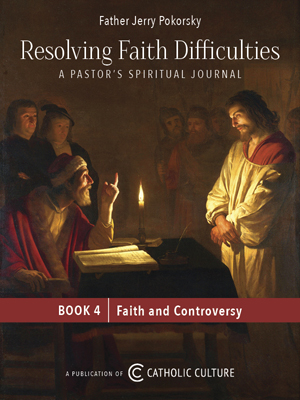collared
By ( articles ) | Aug 05, 2007

The photo above purports to show (Lutheran) Church of Sweden clergy demonstrating yesterday in Stockholm to "break the conspiracy of silence regarding homosexuals, bisexuals, and transsexuals." Few of us, perhaps, would have noticed a great deal of silence on the issue, but I suppose these ministers are specially trained to listen for it.
But my interest was tweaked by a side issue: the marchers' use of the roman collar. In standard progressivist polemic, the roman collar is deplored as a token of clericalism, and more particularly of the hierarchical subordination typified by the Church of Rome. We might expect that progressives, in keeping with their anti-hierarchical convictions, would never let themselves appear in the roman collar, either dressing indistinguishably from the laity or creating an alternative garb more emblematic of humility.
Yet the fact is that attempts at replacement insignia have flopped; no badge expresses the notion "clergy" as unequivocally as the roman collar. This means that -- on those infrequent occasions when progressivists want to be publicly identifiable as clergy -- on goes the collar, out go the principles.
It's not without an amusing side. Those instances on which the forward-thinking brethren summon the bad old hierarchical caste system to their aid do not redound to their credit. Attorneys for priest-defendants regularly stuff them into the too-snug clerics fished out from the depths of the rectory closet, hoping the jury will atavistically respond to the uniform. Here's an example from a churchman indicted for advanced ideas about youth ministry:
Fr Joseph Jordan was a modern priest, always dressed in baseball cap, tracksuit and trainers. One mother remarked that the only time she had seen him in clerical garb was in the dock at Cardiff Crown Court.
In addition to arraignment fashions, the roman collar also comes in handy when television or news cameras are at hand, and it's politically more expedient for, say, Professor Richard McBrien to weigh-in as Father Richard McBrien. Dressed in a jacket and tie, a refractory Catholic academic comes across on the tube as just another refractory Catholic academic, his Holy Orders notwithstanding. (For analogous reasons, when military officers go on television to oppose some aspect of administration policy, the producers make sure they're in uniform.)
And then, finally, there is the public street demonstration, as exemplified in the photo from Stockholm. The marching ministers even put aside their pastel clergy shirts in favor of deadpan Catholic black, lest inattentive spectators mistake them for random amateur cross-dressers. There's a "me too" dimension to their use of the roman collar: "You should take us seriously, because the collar is an emblem of clergyhood and clergyhood an emblem of ecclesial authority and ecclesial authority an emblem of moral seriousness -- not that we are morally serious in fact, but we have fierce political passions for which some kind of public legitimacy is needed."
In a paradoxical way, progressivists' infrequent tactical resort to clerical garb is more "clericalist" than conservatives' day-in day-out use of the same. After all, the conservative can say, "Hey look. I'm a priest around the clock, and I'm just doing what I'm told, just keeping to Canon 284, so I take the multiple headaches along with the occasional advantage that comes with the collar." But the trendy clergyman, who dresses as a layman 99 percent of the time and puts on clerics only as a signal to strangers and only for some tactical advantage, is trading precisely on the moral prestige that society imputes to the clerical caste as a whole. He's saying in effect: "Pay greater attention to my words, because -- when all is said and done -- it's the Church that's speaking." To pull this stunt is to borrow the moral authority that belongs to an institution so as to exploit it for personal gain, and of such is the kingdom of clericalism.
Photo: Le Figaro (AFP/Nackstrand)
All comments are moderated. To lighten our editing burden, only current donors are allowed to Sound Off. If you are a current donor, log in to see the comment form; otherwise please support our work, and Sound Off!
-
Posted by: -
Jan. 30, 2010 8:56 PM ET USA
I suspect the judge appended his statement to preclude someone's regarding his decision was a sanction of assassination as long as it was committed at the clinic.
-
Posted by: Eagle -
Jan. 30, 2010 9:29 AM ET USA
Legally, the Judge was correct. There is no law in the U.S. which authorizes domestic non-military assassination, whether by law enforcement or citizens. The alternative is chaos. That said, the focus for believers must remain on changing the law and evangelization of individuals and the culture. Most of the German people, when shown the horrors of the Nazi genocide after WWII, were horrified and appalled. Hopefully, it won't take a tragedy like losing a War to bring that cultural realization.
-
Posted by: -
Jan. 29, 2010 9:55 PM ET USA
If memory serves, at one time in America slavery was legal and I believe in Germany exterminating the Jews was legal. I suppose that neither Adolf Hitler nor Josef Stalin were imminent threats on any given Sunday in Europe. I guess Churchill saw things differently, which is why Churchill is a statesmea, while Judge Wilbert writes a peon to the State.
-
Posted by: Ben Dunlap -
Jan. 29, 2010 7:46 PM ET USA
"He said that abortion cannot be a threat to anyone because it is legal". I don't see that in his actual words, as quoted here. His use of the word "unlawful" probably refers explicitly to KS Statutes 21-3211 through 21-3214, which specify, among other things, that the use of force is only justified against an "unlawful" threat. Seems a bit of a strain to read more into this than that he was showing, as is customary, that the defense's argument fell short on multiple legal grounds.







